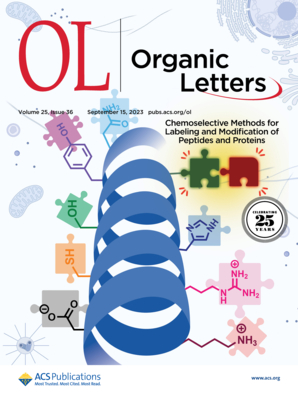Engineering Tryptophan Halogenase RebH for Regioselective Halogenation of Phenolic Compounds
IF 5
1区 化学
Q1 CHEMISTRY, ORGANIC
引用次数: 0
Abstract
Herein, we engineered tryptophan halogenase RebH using alanine scanning and the focused rational iterative site-specific mutagenesis (FRISM) strategy to expand its substrate scope toward phenolic compounds, particularly hydroxyquinolines and hydroxyisoquinolines, with excellent regioselectivity. The optimal mutant, 3-LSR/V80A/F111G, exhibited a 5-fold increase in catalytic activity and an 86.5-fold enhancement in catalytic efficiency (kcat/Km) for 6-hydroxyisoquinoline compared with the template 3-LSR. Furthermore, 3-LSR/V80A/F111G enabled the synthesis of 5-bromo-6-hydroxyisoquinoline on a milligram-scale with >99.9% conversion and 84.3% isolated yield.

酚类化合物区域选择性卤化工程色氨酸卤化酶RebH。
在此,我们利用丙氨酸扫描和聚焦理性迭代位点特异性突变(FRISM)策略设计了色氨酸卤素酶RebH,将其底物范围扩展到酚类化合物,特别是羟基喹啉和羟基异喹啉,具有出色的区域选择性。最佳突变体3-LSR/V80A/F111G对6-羟基异喹啉的催化活性比模板3-LSR提高了5倍,催化效率(kcat/Km)提高了86.5倍。此外,3-LSR/V80A/F111G使5-溴-6-羟基异喹啉在毫克尺度上合成,转化率为99.9%,分离收率为84.3%。
本文章由计算机程序翻译,如有差异,请以英文原文为准。
求助全文
约1分钟内获得全文
求助全文
来源期刊

Organic Letters
化学-有机化学
CiteScore
9.30
自引率
11.50%
发文量
1607
审稿时长
1.5 months
期刊介绍:
Organic Letters invites original reports of fundamental research in all branches of the theory and practice of organic, physical organic, organometallic,medicinal, and bioorganic chemistry. Organic Letters provides rapid disclosure of the key elements of significant studies that are of interest to a large portion of the organic community. In selecting manuscripts for publication, the Editors place emphasis on the originality, quality and wide interest of the work. Authors should provide enough background information to place the new disclosure in context and to justify the rapid publication format. Back-to-back Letters will be considered. Full details should be reserved for an Article, which should appear in due course.
 求助内容:
求助内容: 应助结果提醒方式:
应助结果提醒方式:


